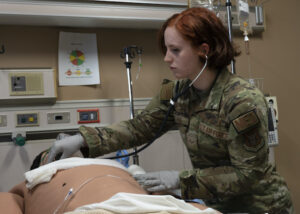
Story by Senior Master Sgt. Theodore Daigle
307th Bomb Wing
Maj. Aquila Haney knew her patient, Andrew, was dying.
The 2nd Medical Group registered nurse could see it in his eyes. Shock was setting in.
She could hear the staggered breathing as his chest filled with air from a bullet wound.
“We’ve got you, Andrew,” Haney said to the patient, exuding calm and poise. “You’re going to be okay.”
Just as calmly, she directed her Barksdale Air Force Base medical personnel team to mitigate the shock and stop the air from filling the chest cavity.
In minutes, the team had the patient stabilized and ready for surgery. But the surgery never happened.
That’s because “Andrew” wasn’t a real person, but an advanced lifelike medical manikin at the Willis Knighton (WK) Innovation Center in Bossier City, Louisiana, where aerospace medical technicians from the 307th Medical Squadron and 2nd MDG took part in a new training partnership with Willis Knighton Health Services here Wednesday.
It was the first time the 307th MDS, an Air Force Reserve unit, and the 2nd MDG, an active-duty unit, had trained together at the facility, according to Maj. Joy Tesei, a 307th MDS physician assistant who helped spearhead the collaboration.
“It’s a win-win anytime the Reserve and active-duty train together, but when you add in the local medical community, it takes it to another level,” said Tesei. “Partnering with the 2nd MDG and Willis Knighton is a true example of leveraging our strengths to build capability and capacity in a resource-strained environment.”
Staff at Willis Knighton Innovation Center provided the Barksdale Airmen with three training scenarios: a gunshot wound, a pediatric overdose, and a non-responsive patient.
The gunshot wound involved an adult male shot while driving to work, the overdose involved a juvenile who mistook medicine for candy, and the non-responsive patient was an elderly man about to be released from the hospital when he suddenly coded.
The realism in all three scenarios impressed Tech. Sgt. Christian Dantes, a flight-certified aerospace medical technician (AMT) assigned to the 307th MDS.
“All three scenarios were very smart, well-planned, and creative,” he said. “The staff at Willis Knighton based the scenarios on things they had experienced or had seen in the news.”
Dantes transitioned to the AF Reserve after six years on active duty and serving in an emergency room. Despite his depth of experience, he said the quality of training was eye-opening, citing the overdose scenario in particular.
“The amount of knowledge they had was truly great, especially for medics in upgrade training,” he said. “They made sure we understood what it looks like when a child is crashing because it’s very different from an adult.”
Dantes was equally impressed with how the technology at WK’s Innovation Center added to the training.
“On their manikins, you can hear the difference between crackling and gurgling lungs; they could speak to us, and we could check their eyes for reactions,” he said. “All those things make a difference in how you approach care for a patient.”
The manikins also allowed the Airmen to push medications instead of just sticking needles and simulating administration.
That type of realism helped newer medics like Airman 1st Class Ashlynn Wiggins, a 307th MDS AMT.
“It creates a practice-like-you-play situation,” she said. “Simulations and book knowledge only prepare you so much for the real world, so having equipment like this provides important hands-on experience.”
Wiggins also said the realism and opportunity to work with active-duty AMTs helped her deployment readiness, a high priority within the Air Force Reserve Command.
“Some traditional reservists have civilian jobs that aren’t related to the medical field, so the realism here really helps with proficiency,” she said. “I want training like this so I can be confident and ready when it is time to go downrange.”
Chastity Moran, a registered nurse who serves as WK’s Virtual Hospital Coordinator, said the plan is for the collaborative training to continue every month throughout 2024.
That’s good news for Barkdale’s AMTs.
“It’s a huge opportunity for our Airmen to complete upgrade training and be deployable faster,” said Dantes. “And it’s the kind of realism that makes you want to train harder.”
It’s also good news for local communities since many traditional reservists hold medical jobs in their civilian careers.
“It’s a local solution that will have far-reaching benefits not only on base but within our local community and across the globe,” said Tesei.